CHAPTER V
DIFFICULT TIMES
1930 – 1940
The first five years of this decade was perhaps the most turbulent period in the history of Pittsfield. To quote Dickens, “It was the best of times; it was the worst of times.” The schools, churches and social organizations seemed to be getting along unusually well. M.C.I. was having some particularly good years. Its athletic and debate teams were winning statewide recognition and its graduates were doing well in the colleges. Three Pittsfield boys, Roy Huff, Roland Graves and Thomas Johnston, won outstanding honors at Bowdoin. The churches, particularly the Universalist, were experiencing vigorous growth; and the fraternal orders, the Grange, and the business and social clubs were especially active. A psychologist has attempted to explain this increased interest in things spiritual and cultural as an escape from a rapidly worsening economic situation throughout the world. This might very well be applied to our town.
Local politics became more and more hectic until finally in a climactic annual meeting, the entire Board of Selectmen was voted out of office. The 1930 town meeting was a real humdinger. Thurlough, as usual, campaigned hard, speaking before a large Chamber of Commerce meeting at The Lancey House and calling on the rural voters as was his custom. He was reelected by a vote of 694 to 410 over George Kimball, one of the largest ballots ever recorded. Ray Badger, who was a very popular political personality at this time, was continued in office as Superintendent of the Water Works and Chief of the Fire Department. As nearly everyone has learned who has mixed into town affairs, politics is a fickle game, and before long the cry is heard, Its time for a change. This happened in Pittsfield.
It was in business, however, that the greatest upheaval occurred. The decade started off with two changes that were destined to brighten downtown patrons. Dans Lunch opened on the corner of Central and Main and until Mr. Tozier, its genial proprietor, retired, this busy little restaurant catered to the appetites of hundreds of satisfied customers. Farther up the street, the R. H.
117
Berry Drug Store was sold to Donald F. Humphrey, a young pharmacist and native of Pittsfield. Don proved to be a progressive businessman and over the years built his store into one of the finest in the state. It has always been a popular rendezvous for young and old alike and today one will usually find a group gathered for the morning papers and the local gossip. It has become the Rialto of Pittsfield.
Two other changes took place on the street in the early thirties. In 1933, L. M. Knight purchased the lumber and building supplies business of H. F. Walker. In 1931, L. H. Goodwin, gave up his clothing store which was located in the bank block. He had been in business 26 years. Less than two years later, Clyde Nichols of Detroit reopened the store and carried it on until he retired and sold to Gilbert Spear.
WOOLEN MILLS IN TROUBLE
The years 1930 and 31 had been really rough on the woolen mills. The Waverley mill had been down for nearly two years. Just how bad things were are revealed in a letter Felix Ramm, a boss weaver in the Pioneer, wrote to The Advertiser. After mentioning that the depression in textiles was prevalent throughout the industry, he got specific by pointing out what had happened in Pittsfield. “There are 160 weavers in Pittsfield,” he wrote; “40 in the Waverley, 40 in the Sebasticook, and 86 in the Pioneer. The Waverley and Sebasticook are down. The Pioneer has doubled up on looms — one man for two looms — so 40 more are out of work. This makes a total of 120 weavers out of work and 40 working part time. So what can we do?” he asked. “Old hands come to me for work and I can’t give it to them because there just aren’t any jobs.” Mr. Ramm solved his own problem by leaving Pittsfield for a position in a mill where the prospects were a little brighter, but more than a hundred skilled workers couldn’t make the move. Some of them faced relief, and in those days before unemployment insurance, their situation was tragic.
At first it was hard to believe that The American Woolen, giant in the textile industry, could be in financial trouble, but in 1932, the stark reality of their plight became evident when the
118
company announced the sale of all real estate not directly connected with mill operation. The auction took place and it was heartbreaking. Homes that today sell for $10,000 went for $600. It was one of Pittsfield’s darkest days.
There could be no doubt now that the textile business, insofar as the local units of the American Woolen Company were concerned, was nearly over. There may have been a few who still clung to the belief that the company would yet pull through, but two years later (1934), all doubt was removed and the end came swiftly and harshly. A brief notice appeared in the Maine papers that the Waverley and Sebasticook would go on the auction block. At this sale the Waverley went to Willard Cummings for $9200 and the Sebasticook was sold through an agent to Lancey Milliken for $3500, and shortly, Mr. Milliken moved into the mill from his plant on Hunnewell Avenue. The Pioneer was to stagger on for a few more years and then, after a temporary spurt due to World War II, went the way of its former associates. Of the Dobson mills, it was the first to come and the last to go.
PITTSFIELD NATIONAL BANK CLOSED
The next blow that came was a killer — The Pittsfield National Bank closed! Only a year or two earlier it had been singled out as one of the strongest institutions in the state. Its stock was high and jealously guarded by Mr. Manson and his Board of Directors. It became the victim, along with many others, of the bank holiday in the first few months of the Roosevelt Administration.
Early in April (1933), the depositors met at The Lancey House with Conservator, H. R. Coolidge, and a committee was chosen to represent the depositors consisting of G. M. Lancey, Chairman; Mary Spear, Secretary; A. P. Bigelow, William Bigelow, Dr. Carl S. Coffin, E. B. Reed, H. L. Goodrich, and E. N. Vickery. The Committee recommended taking immediate steps to reorganize the bank. In May, a notice of reorganization stated that there were $736,000 acceptable assets. The remaining assets of $1,348,300 had a market value of $702,000 to be liquidated, which, with stockholder assessment, was to go toward 65% due the depositors.
Later in that month, a meeting of depositors was held in Union Hall with H. R. Coolidge, Conservator. E. N. Vickery was chosen
119
Chairman and Sanger M. Cook, who had recently been elected Representative to the Legislature, was named Secretary. Attorney Issacson of Lewiston explained the steps necessary in reorganization. A committee was chosen to solicit stock for the proposed bank. In August, the stock subscribers met again in Union Hall to reorganize. S. M. Cook was Chairman; E. N. Vickery, Secretary. Directors chosen were A. P. Bigelow, William Bigelow, C. S. Coffin, H. L. Goodrich, Clarence S. Spaulding, H. R. Coolidge, H. F. Walker and E. N. Vickery. A. P. Bigelow was named President and George A. Moore of Skowhegan, Cashier. The new bank, The First National Bank of Pittsfield, Maine, was opened September 25th.
R. H. Berry replaced Mr. Coolidge as Conservator in January 1934. Mr. Berry was a highly respected citizen and, although there was considerable impatience at times, the assets of the old bank were eventually liquidated and in September 1939, the depositors received their final dividend of .421%, making a total of .9171% of their original savings. At this time, Arthur Ricker of Waterville was serving as Conservator. It was a sad experience, but it resulted in improved banking regulations, for which we can all be thankful.
AIRPORT PROPOSED
In those five years there were other items of lesser interest but worthy of mention. One of the first of the alphabetical administrations created by the new Democrat regime was the Civil Works Administration — the CWA. Mr. John McDonough was the state administrator, and he appointed Ray Badger local administrator. Mr. Badger had many projects to supervise, including the repair of the library roof, the renovation of the interior of the town farm, building cemetery lanes, repairing rural roads, and pruning shade trees. One project that had far-reaching importance to Pittsfield was the construction of an airport. Mr. McDonough was an old baseball player and he urged many of the towns to build baseball fields. Our officials preferred and strongly recommended an airport and after several meetings in Augusta, a grant of $25,000 was made to Pittsfield for the survey and initial construction of two runways. Administrator Badger appointed Ralph Cianchette Foreman and work was started. As a result of this decision, Pittsfield was later
120
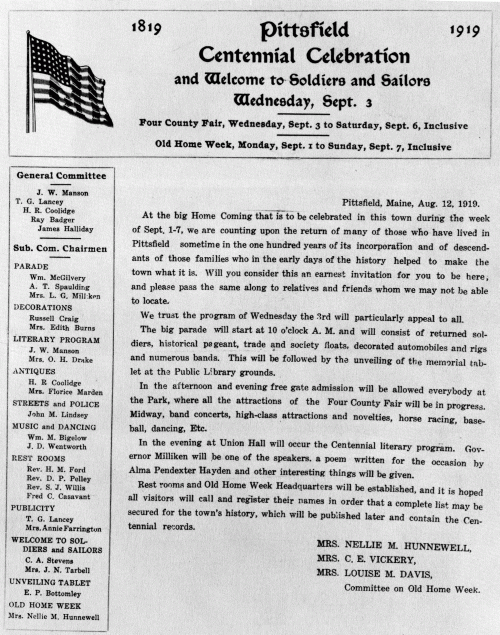
[Page 120.1]
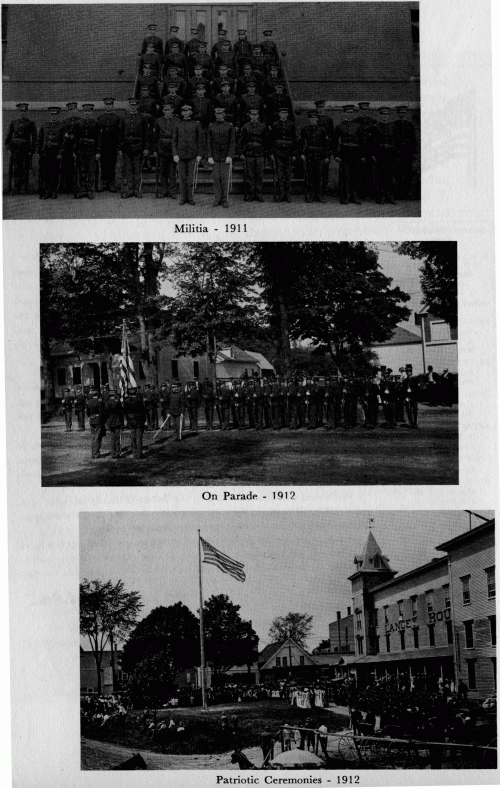
[Page 120.2]
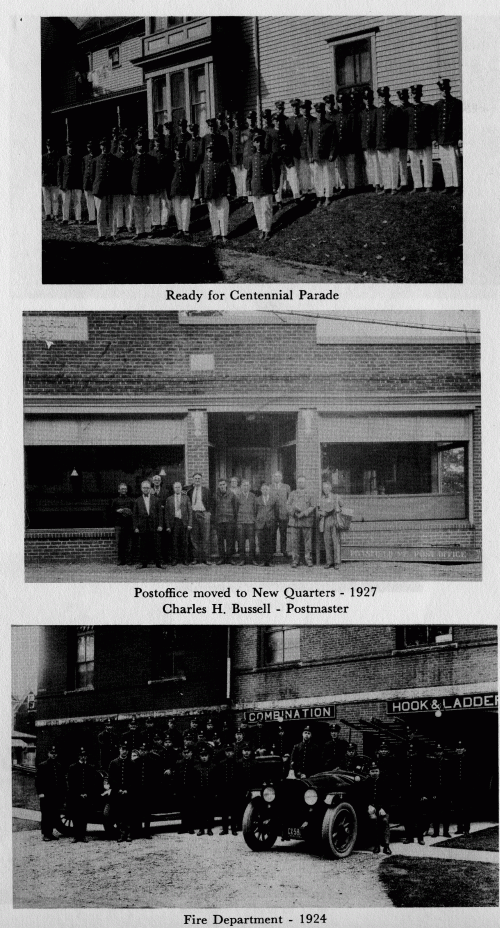
[Page 120.3]
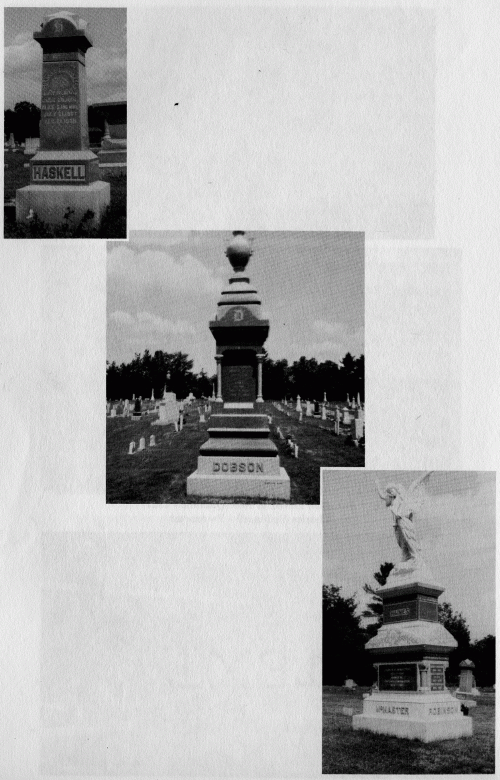
[Page 120.4]
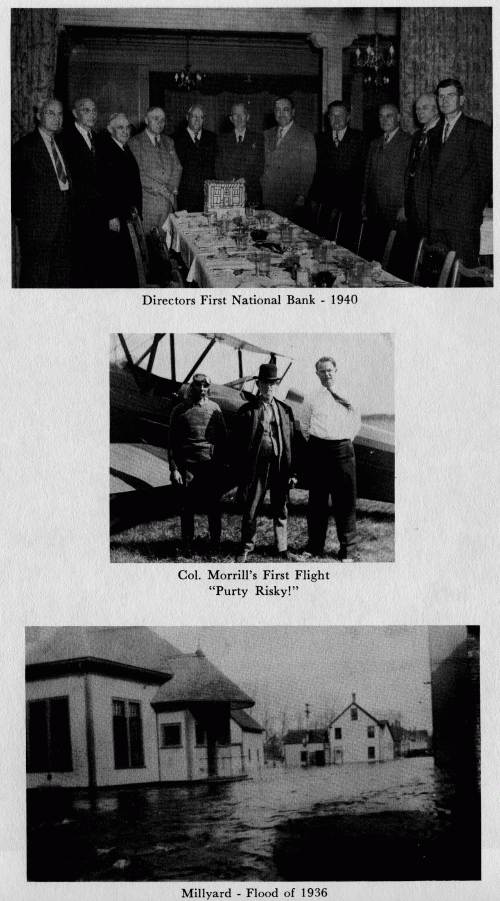
[Page 120.5]
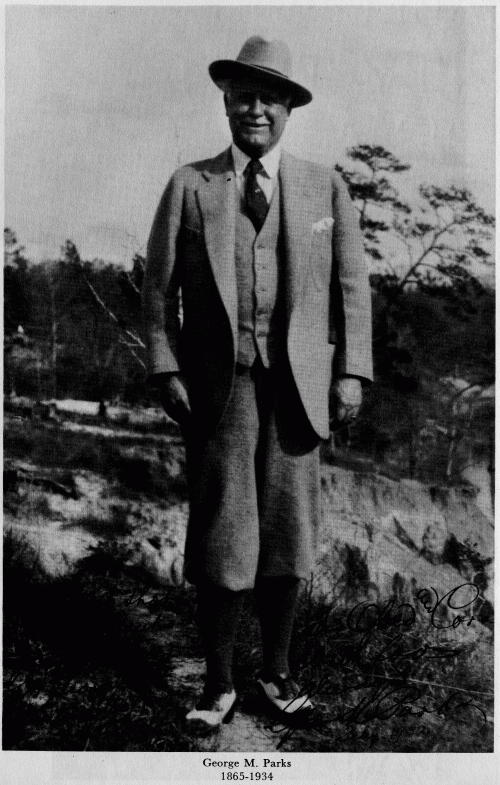
[Page 120.6]
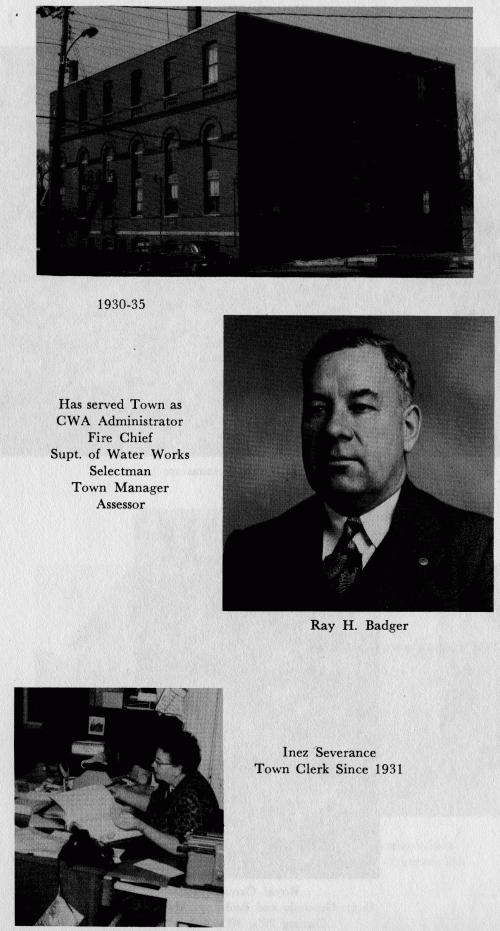
[Page 120.7]
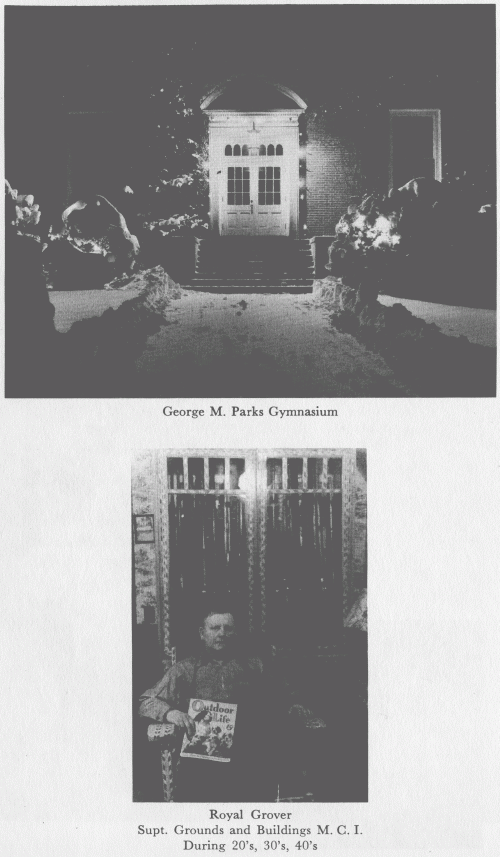
[Page 120.8]
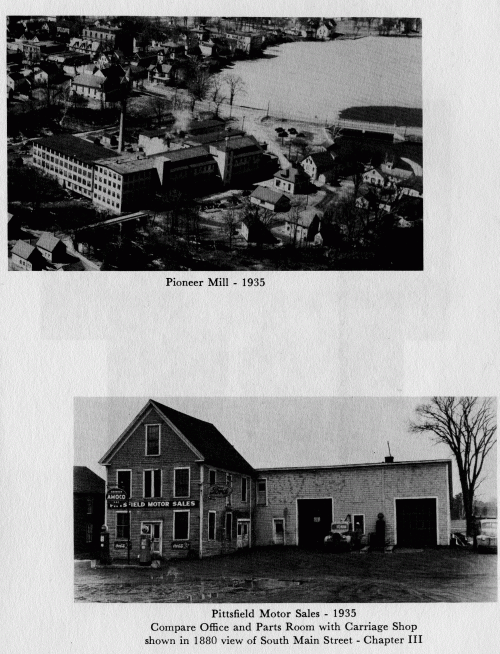
[Page 120.9]
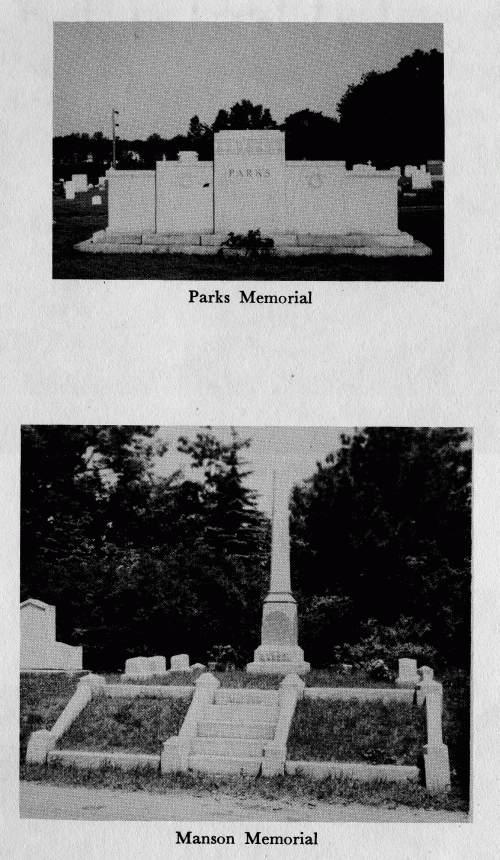
[Page 120.10]

[Page 120.11]
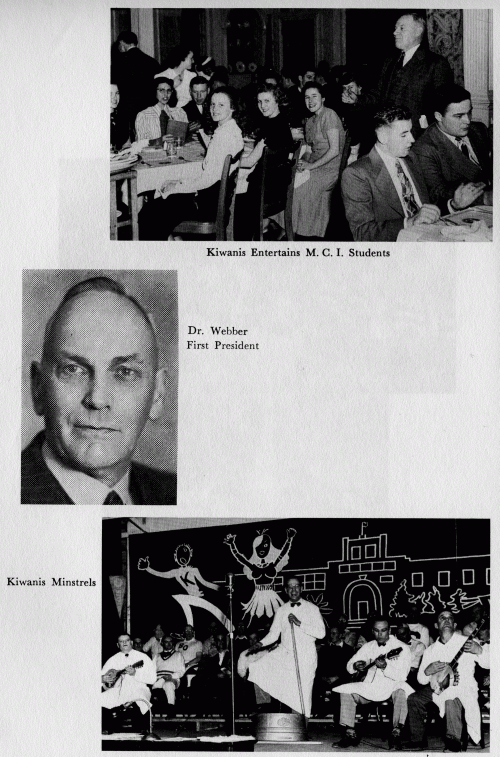
[Page 120.12]
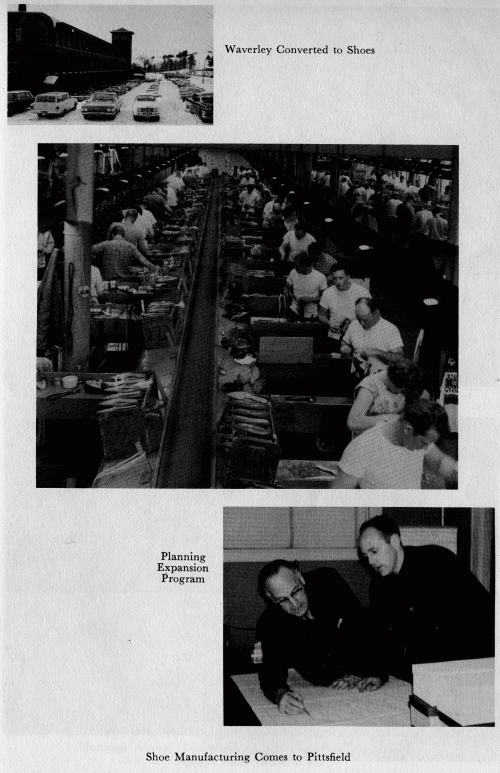
[Page 120.13]
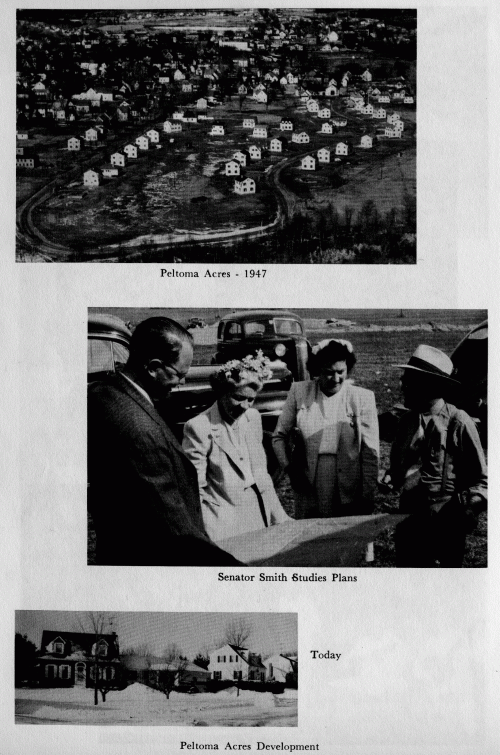
[Page 120.14]
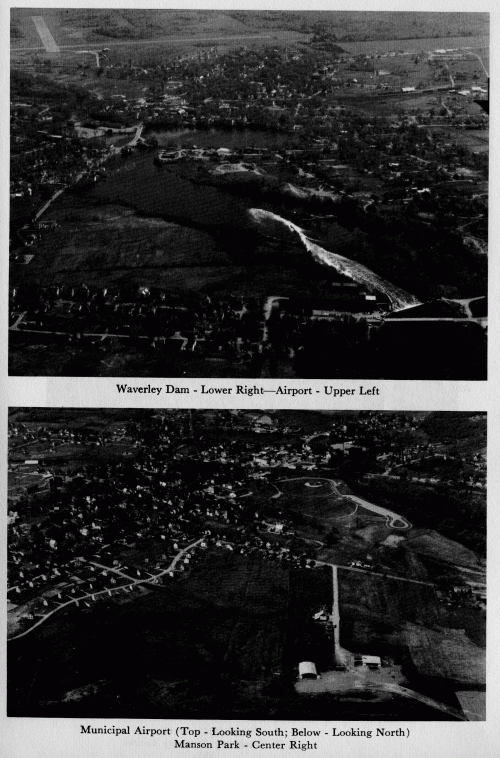
[Page 120.15]
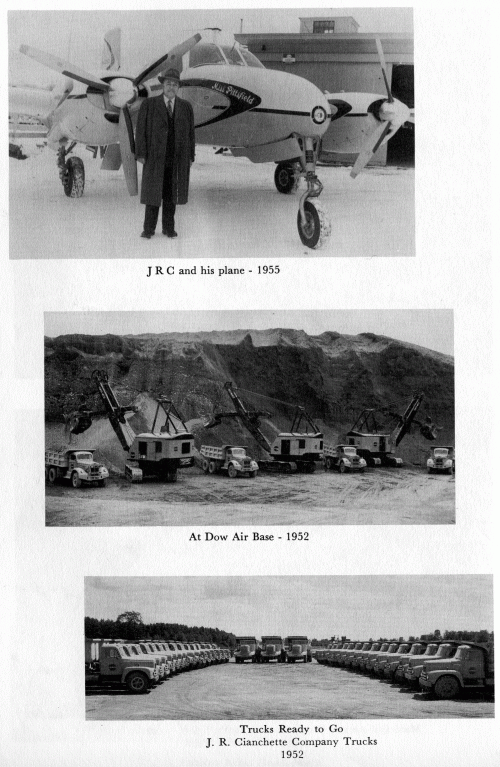
[Page 120.16]
designated an official landing field on the first Maine airway map, and when the war came and a cadet program inaugurated at M. C. I. this field was one of the few to be developed. Representative Cook, Mr. Badger, and Colonel Morrill made the first official flight from this new field.
Another construction project of importance to Pittsfield was the concrete highway through town. Included in this road work were the two concrete bridges across the Sebasticook on North Main Street.
There were several serious fires in 1933. The Lehr block at the corner of Hunnewell Avenue and Main, today occupied by the A & P store, suffered a $15,000 loss; 18 head of cattle were destroyed when the old Powers homestead in West Pittsfield was burned to the ground; and the Vickery block was severely damaged in a fire that spread through the second floor to Attorney T. A. Anderson’s office, the municipal court room, and the Parks Brothers Insurance Office.
Pittsfield gained considerable favorable publicity in the entertainment world through the talents of Edna Barstow (formerly Edna Martin), Vera Brown, Ray Wright and Charles Cloutier, an M. C. I. student. These four were frequently called upon for local programs and appeared most successfully on WLBZ in Bangor.
The Boys Band was also very popular at this time. The writer remembers vividly one time when he needed assistance at a political rally in Jackman. Mr. Fairbanks, their leader, gave permission to transport the organization by trucks and cars over ninety miles of lonely roads to this border town where they put on a stirring performance and no doubt were largely responsible for a most satisfactory vote the following September. The boys, who are now middleaged men, still like to reminisce about that trip.
In 1933, Harry Cornforths store was robbed. One November night the thieves backed a truck to the rear entrance and practically cleaned out the store. The loss was estimated around $2000. The criminals were apprehended in New York state, but very little of the loot was ever recovered.
The Democrats were very active during this period, particularly from 1933 to 1937 when Governor Brann was in office. James Daily replaced Charles Bussell as Postmaster; R. H. Berry, as we have seen, was appointed Conservator in the bank liquidation
121
proceedings; and Ray Badger became head of the ERA and the CWA. At one time he had nearly a hundred workers under his supervision. One of the hardest workers in the party was Jim Lagorio, owner of a popular cigar and fruit stand on Main Street. Jim was a fine fellow and got along great with Republicans and Democrats alike. When the townspeople helped Colonel Morrill to put on his last racing program in the fall of 33, just before the track was converted into an airport, both parties cooperated to get the Governor to Pittsfield to watch the dynamic old Veteran conduct his farewell racing program. The Governor seldom went through town that he didn’t stop at Jim’s store to say hello and get the latest word on the political situation in the area. Yes, Jim was a great personality, a rugged political opponent, but always fair.
Death claimed several prominent citizens during this period, among whom were Capt. William Ross; Dr. E. C. Bryant, who died in Medford, Mass.; Benjamin S. Mathews; Alec McNabb, former owner of The Lancey House; George G. Gage, a popular writer and storyteller; George M. Parks, who died while on a hunting trip in the Carolina’s, was born and educated in Pittsfield, was a most successful life underwriter in Providence, R. I., and always a good friend of his native town. In his will, he generously remembered M. C. I. and the Universalist Church.
1935 – 1940
The second half of the 30’s began to show signs of improvement. The economy of the country was responding to the pump priming measures of the Administration in Washington and the unbounded optimism of President Roosevelt was infectious. The various relief projects had taken care of the most serious unemployment problems and now many of those who had benefitted temporarily were finding jobs in private enterprises. For example, most of those who had worked on the local airport project were by this time on the payrolls of our rapidly growing contract companies. We began to read more and more frequently of bridge and road building jobs being awarded to young Pittsfield contractors, second generation names of those Italian families that settled here in the early part of the century. Ralph Cianchette and James Frederick,
122
the Susi Brothers, J. R. Cianchette, and Ralph Giovannucci were frequently mentioned. The first realization of the magnitude of their operations and the importance of this industry to the economy of our town came in 1940 when a $100,000 fire leveled the J. R. Cianchette shops on lower South Main Street. The equipment listed lost in that blaze revealed dramatically that our local contractors were getting into the big time.
Changes in other fields of business indicated that perhaps recovery had begun. L. A. Dysart, a young, imaginative and hardworking product of Skowhegan, opened a 5 and 10 store in the old Perkins block. In the same month of that year (1935), T. F. Connor leased his store to the Butler Brothers of New York, and a new shoe factory was located on the third floor of the Martin block by Vaughn Reed and John Plummer. The following year this operation was taken over by the Atlas Shoe Company and managed by Sidney Goodman. In the Pioneer mill, Andrew Younger was promoted to plant superintendent, a move that was reassuring to many employees. In 1936, Lyle McCrillis purchased the Craig Coal Company and Tim Burch was gaining renown as a gracious host at The Pickwick Cabins. In 1936, Charles Peterson replaced Harvey Patterson as manager of the Central Maine Power division and four years later, the company opened a store on Main Street. The same year (1940), Bill Lehr added a coffee shop to The Lancey House. All of which gave evidence that confidence in the future of Pittsfield was being restored.
Along with these changes in our industrial life there were other activities going on that contributed a great deal to a better community life. J. W. Manson sometime before had offered to the town a large tract of land bordering the west bank of the Sebasticook River from the railroad tracks to the village cemetery to be used as a public park. He stipulated that the park should be named in memory of his mother, Mary Ann Lancey Manson. The town gratefully accepted this generous gift and a large number of citizens expressed their personal thanks to Mr. Manson through the pages of The Advertiser. The Park was not fully developed until later when Mr. Manson through his will provided funds for that purpose, but in 1935, an area within this tract was prepared and dedicated for a baseball field. Appropriate ceremonies were held and
123
until his death, Mr. Manson had the privilege of watching M. C. I. and the town teams use the field.
Another substantial gift came to the community through the will of George M. Parks who bequeathed to M. C. I. funds to erect a gymnasium on the school campus. This building was completed in 1936 and has served to this day as a center for indoor athletics.
A third location for community enjoyment was provided by the American Legion, an organization that had been active since its incorporation following the war. The Legion purchased the Methodist Church on Manson Street and converted it into a spacious home for their regular meetings and special events. It was appropriately dedicated in 1935 before a large gathering of Legionnaires, townspeople, and visiting notables, among whom was Governor Brann.
During this period of recovery there was, as we might expect, more than ordinary interest in local politics. Thomas A. Anderson was appointed municipal judge in 1935 by his old college friend, Governor Brann. S. M. Cook, who had served two terms in the House of Representatives, announced his candidacy for the State Senate, and the Rev. Clarence Leckemby of the Baptist Church, first ran for Congress on the Republican ticket and then, following his defeat by the Honorable Clyde Smith of Skowhegan, ran as an Independent candidate and was defeated a second time. Russell Craig, who had been active in Repubican politics in the town, the county, and the state, decided that he would try for Secretary of State. He lost out by a thin margin, but continued to be active in legislative affairs.
TOWN MANAGER PLAN ADOPTED
The political event, however, that caused the most interest locally was the question of changing our form of government to a town manager plan. Not since the days of Jesse Connor had there been a more emotional discussion. As we would expect, the incumbent selectmen, assisted by the fiery Clyde Martin, put up a hot fight. The sponsors of the town manager form of government had for a number of months been laying the groundwork for their battle under the direction of L. M. Knight, Dr. Olga Gross, and
124
several representatives of some of the leading organizations. Both the proponents and opponents appeared before local clubs, publicized their views in The Advertiser, and spoke at public meetings in Union Hall. When the vote was taken at a special town meeting, the proponents won and the machinery was set in motion to put the plan in operation.
The first town manager was Mr. A. L. Thorndike, a civil engineer and graduate of Tufts College. Among his duties was to serve as Superintendent of the Water Works, which, of course, brought about the resignation of Ray Badger who had succeeded Alonzo Burse and served the town for 17 years. As we would naturally expect, there were rankled feelings for some years to follow. Poor Mr. Thorndike had a rather rough time and after a year of trying to do a creditable job, decided to resign. C. R. Ames, who had served the town in various capacities, was then appointed Manager, to be followed later by Mr. Badger. Several years passed before the voters once again employed an outsider for the post. The town, however, never again returned to the old system of selectmen, but there has always been more or less controversy relating to this office. Over the years, town managers have come and gone — their tenure of office has been somewhat limited. If any reader wishes to pursue this phase of our political life and wishes to be amused, I suggest that he read some of the letters to The Advertiser previous to the March town meeting of 1939, particularly one by Clyde Martin when he answers the question, “When Can a Poll Become a Pole Cat?”
The social life continued about as usual during this period. The Tuesday Club met regularly, the church auxiliaries were busy putting on suppers and otherwise raising money, and the lodges were well-attended. The Mens Club at the Universalist Church was particularly strong. Attendance had grown tremendously and the members were enjoying especially fine programs. The Garden Club was in the news frequently. A spring meeting at Mrs. Sadie Mayo’s lists the following members: Bessie Maloon, Imogene Burdick, Ina Fuller, Jessie Freeman, Maud Getchell, Nellie Vickery, Gertrude Humphrey, Earl Gordon, Ada Hopkins, Hazel Collamore, Bertha Webber, Lena Marsh, Kate Givens, Bertha Longley, Lilla Cargill, Grace Rogers, Ellen Cowan and Marion Waldron.
125
The Grange loved to put on plays. At one meeting in 1937, a dramatic production “The Meddlesome Maid” was produced with Leland Inman, Madeline Small, Perley Dexter, Flora Brooks, Foster White, Frances Goodrich, Hazel Brooks, Ruby Lancaster, and Harry Dunton roundly applauded for their interpretation of the characters in this play.
KIWANIS ORGANIZED
The last of this era (1940) saw the Kiwanis Club organized. An attempt had been made a short time before to start a Lions Club, but it had not succeeded. The Kiwanis got off to a fine start in 1940 and has been going strong ever since. Never in the history of Pittsfield has a service organization been more active or accomplished more good than this group of men. Besides its principal goal to help the youth of the community by setting up scholarships, encouraging church attendance, and sponsoring recreational areas such as the ski slope and the swimming pool, it has made a very substantial contribution to the economy of the town by making it possible for at least two industries to locate in Pittsfield.
The first President was Dr. M. A. Webber who served for two terms and then went on to become Lieutenant Governor. Other officers were Roy U. Sinclair, Vice President; James Parsons, Secretary. Directors: S. M. Cook; W. W. Lehr, Sr.; J. R. Cianchette; Joseph Buker; Charles Peterson; Donald F. Humphrey; Fred McCully; and Earle E. Friend. Later, Thomas Shatney became Secretary and has served the club faithfully and efficiently ever since. He is recognized throughout the district as one of the ablest secretaries.
In competitive activities, Pittsfield again won statewide recognition in rifle matches. In 1936, Ray Tweedie became state champion in the expert division and was awarded a trophy donated by J. R. Cianchette. In football, M. C. I., under the coaching of Lindholm and Louder, won the state preparatory school championship in 1937. In these days when town boys competed with fifth year stars from all parts of New England, Pittsfield was represented by Stafford, Daily, Lyons, and Hersey. Stafford was elected honorary captain for the year. Coach Harold Louder was also a local boy who had played brilliantly for M. C. I. and Bates.
126
In debating, M. C. I. won the New England Preparatory School Championship in 1938. Earl Tweedie, Alma Ellingwood, John Robinson, and Perley Whitten were members of a great team that defeated Cushing Academy in the finals at Bates College. They all did a marvelous job and brought home a beautiful trophy which today is treasured by the school.
During these five years Pittsfield suffered three minor disasters. First, there was the big flood of 1936. Spring freshets were not uncommon, as we have seen, but the ’36 flood reached an all-time high water mark. The red bridges to the island had to be blown out to relieve the danger of an ice jam. As it was, the water went high over North Main, flooded the mill yard and endangered all the bridges along the river to the Kennebec. The road through the flats south of the village was impassable and there was three feet of water over the road leading into Burnham.
UNION HALL DAMAGED BY FIRE
Early one morning two months later Mrs. C. C. Merrill discovered a blaze breaking out in Union Hall and before it could be extinguished it had burned through the roof destroying both the Masonic and IOOF halls and doing heavy damage throughout the building. The loss was estimated at $40,000.
In 1939 there was a spectacular fire on Grove Hill when Carey Gee’s farm buildings were leveled in a midwinter blaze.
Personalities who made the headlines in those last years of the 30’s were numerous. Mr. and Mrs. C. E. Vickery celebrated their 60th wedding anniversary in 1935; Harris Mathews, Jr., was made the first Eagle Scout of Troop #128. This troop is one of the oldest in the nation. When scouting first came to this country, a few energetic citizens got in touch with the pioneers in the movement and brought to Pittsfield one of the first charters to be issued. In 1937, Rev. Henry Osgood became pastor of the Baptist Church; Mr. and Mrs. Dominick Cianchette observed their 45th wedding anniversary; Rev. and Mrs. Milo G. Folsom visited in England. In 1938, Father Leo Carey was honored on the 10th year of his service as priest of St. Agnes Parish. The occasion was observed at the Legion Hall and friends from all parts of the state came to congratulate him and wish him well. Among the guests was Governor Brann.
127
Three outstanding citizens took up residence in Pittsfield in 1939. William Springer became Superintendent of Schools and remained in that position until he retired in 1964; Dr. E. Y. Harvey came here from Greenville and practiced dentistry until he returned a few years later to his native town. While here he made many friends and was active in community affairs. He was the second president of Kiwanis and a favorite in its minstrel shows. Dr. Ernest D. Humphreys came to Pittsfield from Jackman and practiced medicine until his death in 1964. He was a beloved and highly respected physician.
During the latter half of this decade a number of prominent names appeared in the obituary columns. Among them were Eugene Powers, Broadway actor, who was buried in the family lot in West Pittsfield; Thomas G. Lancey, hardware merchant and grandson of the original Colonel Lancey; T. E. Getchell, also hardware merchant, who served Pittsfield as Town Clerk for 38 years; Henry F. Libby who had dealt with the public most of his life as druggist, postmaster, and Cashier of the Pittsfield National Bank; Robert Smith, druggist; Fred Peasley, merchant, formerly a farmer in Palmyra; Mrs. T. E. Getchell, Trustee of M. C. I.; C. E. Vickery, outstanding businessman all his life; Rev. Milo G. Folsom, Pastor of the Universalist Church; William Bigelow, Director of the First National Bank; Dr. W. B. Trickey, outstanding physician; Frank Fairbanks, undertaker and organizer of one of the finest boys bands in the history of Pittsfield; J. E. McMichael, businessman and civic leader; and Harry Condon, Assistant Postmaster, and interested in youth work, particularly the Boy Scouts.
So another era in the life of Pittsfield was concluded. It had been a hectic ten years, filled with tensions and hard times, but during it all chins were up and as the period ends optimism and hope were in the air. This hope was soon to be translated into reality in a resurgence of industrial activity that was reminiscent of the 80’s and 90’s.
128
|
